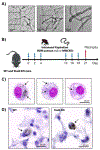STAT6-Dependent Exacerbation of House Dust Mite-Induced Allergic Airway Disease in Mice by Multi-Walled Carbon Nanotubes
- PMID: 33860111
- PMCID: PMC8043620
- DOI: 10.1016/j.impact.2021.100309
STAT6-Dependent Exacerbation of House Dust Mite-Induced Allergic Airway Disease in Mice by Multi-Walled Carbon Nanotubes
Abstract
There is increasing evidence that inhaled multi-walled carbon nanotubes (MWCNTs) can have harmful effects on the respiratory system. Rodent studies suggest that individuals with asthma may be susceptible to the adverse pulmonary effects of MWCNTs. Asthma is an allergic lung disease characterized by a TH2 immune response that results in chronic airway disease characterized by eosinophilic lung inflammation, airway mucous cell metaplasia, and airway fibrosis. Signal transducer and activator of transcription 6 (STAT6) is a transcription factor with multiple roles in TH2 type inflammation. Herein we sought to examine the role of STAT6 in the exacerbation of house dust mite (HDM) allergen-induced allergic airway disease by MWCNTs. Male wild type (WT) and STAT6 knockout (Stat6 KO) mice were dosed via intranasal aspiration on days 0, 2, 4, 14, 16 and 18 with either vehicle, HDM extract, MWCNTs, or a combination of HDM and MWCNTs. Necropsy was performed on day 21 to collect bronchoalveolar lavage fluid (BALF), serum and lung tissue. MWCNTs exacerbated HDM-induced allergic endpoints, including eosinophilic lung inflammation, mucous cell metaplasia, and serum IgE levels. HDM-induced eosinophilic lung inflammation, mucous cell metaplasia, and serum IgE and exacerbation of these endpoints by MWCNTs were ablated in Stat6 KO mice. In addition, airway fibrosis was significantly increased by the combination of HDM and MWCNTs in WT mice but not in Stat6 KO mice. These findings provide new mechanistic insight by demonstrating a requirement for STAT6 in MWCNT-induced exacerbation of allergic respiratory disease.
Keywords: STAT6; allergens; asthma; carbon nanotubes; house dust mite.
Conflict of interest statement
Declaration of competing interests The authors declare that they have no known competing financial interests or relationships that could have appeared to influence the work reported in this paper.
Figures







References
Publication types
MeSH terms
Substances
Grants and funding
LinkOut - more resources
Full Text Sources
Other Literature Sources
Research Materials
Miscellaneous

